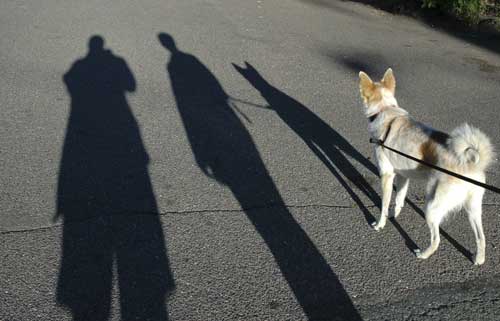 |
PhotoLuminations: Photography and StoriesJerry Halberstadt: Seeing the story, making a difference |
 |
PhotoLuminations: Photography and StoriesJerry Halberstadt: Seeing the story, making a difference |
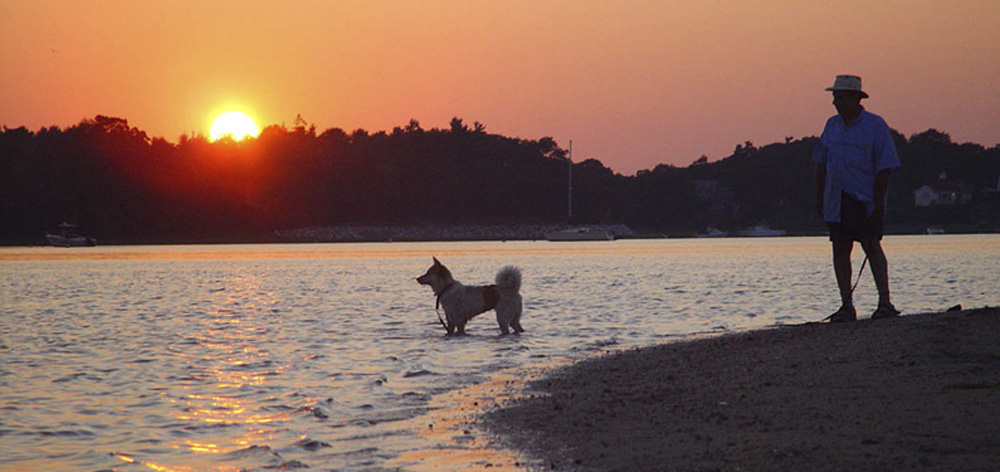 Photo of Jerry and his dog, Keren Copyright © 2003 Claudin Poyant
Photo of Jerry and his dog, Keren Copyright © 2003 Claudin PoyantMy goal is to create fine photographs that capture not only what is visible, but what I have learned and what I feel, and that will engage the viewer in a dialog with the subject. When I photograph people, social settings, or natural environments I am not only an observer, but also engaged in a dialog with the subject. I form a relationship with people and learn about them as I photograph. In the same way, I respond to a natural scene in a subjective manner, and I engage in a dialog, trying to "see" or to "hear" what the scene is saying to me. I sometimes feel a message has been written in nature, and my role is simply to record and transcribe it to make it accessible to others as natural inscriptions. You can read stories and essays on some of my interests and concerns.
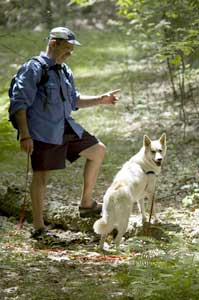 Therefore, I am most comfortable with the 35mm format, although I have worked with large view camera formats, as well as medium format. My approach is essentially the same for working on a documentary record of a social setting or a landscape. I learn how my lens and camera record a scene, and then I "see" the scene in front of me through my camera's eye. I tend to react immediately to a particular concatenation of light, angle, and subject--something speaks to me. Thus I need to be able to compose, focus, and make the exposure very quickly in order to capture the essence of the scene. This makes it essential for me to be able to handle and control the camera instinctively and accurately. For this reason, and for 40 years, I used the Nikon F single lens reflex with a few lenses of excellent quality. The camera I use currently is a Nikon digital single lens reflex, again with excellent lenses. The digital camera provides a wealth of automation; however, it is sometimes difficult to use because of design flaws and technical complexity. Nevertheless, the shift to digital gives me the ability to manage and control the whole workflow process in the computer. I generally do not use a tripod but compensate where necessary with a vibration-reduction lens. Even though my first exposure, made instinctively, is often the best picture, I will usually take a number of exposures of a scene in order to analyze and capture variations; it may take longer to finally select the final picture than to expose the whole series.
While I impose high standards on myself, I do not measure success by technical criteria, but rather by the immediacy and strength of the image and the ability to communicate an idea or a feeling.
Therefore, I am most comfortable with the 35mm format, although I have worked with large view camera formats, as well as medium format. My approach is essentially the same for working on a documentary record of a social setting or a landscape. I learn how my lens and camera record a scene, and then I "see" the scene in front of me through my camera's eye. I tend to react immediately to a particular concatenation of light, angle, and subject--something speaks to me. Thus I need to be able to compose, focus, and make the exposure very quickly in order to capture the essence of the scene. This makes it essential for me to be able to handle and control the camera instinctively and accurately. For this reason, and for 40 years, I used the Nikon F single lens reflex with a few lenses of excellent quality. The camera I use currently is a Nikon digital single lens reflex, again with excellent lenses. The digital camera provides a wealth of automation; however, it is sometimes difficult to use because of design flaws and technical complexity. Nevertheless, the shift to digital gives me the ability to manage and control the whole workflow process in the computer. I generally do not use a tripod but compensate where necessary with a vibration-reduction lens. Even though my first exposure, made instinctively, is often the best picture, I will usually take a number of exposures of a scene in order to analyze and capture variations; it may take longer to finally select the final picture than to expose the whole series.
While I impose high standards on myself, I do not measure success by technical criteria, but rather by the immediacy and strength of the image and the ability to communicate an idea or a feeling.
I take great care in printing each image, and use only materials with archival permanence, out of respect to the viewer. I don't do limited editions, but instead print open editions. The reason is that photography is a print medium that permits unlimited copies, all of high quality and all originals. The concept of a limited edition is to create an artificial scarcity to justify a higher price as a "collectible." However, Ars longa, vita brevis--Life is short, art is lasting; to my regret, I am old enough so that the actual number of prints I can make may impose a practical limit to edition size. At the same time, I enjoy being able to continue to learn a new technology and to create new images. (Photo of Jerry and Keren, Copyright © 2005 Ari Halberstadt)
My mother, Luba, an immigrant from a shtetl in Russia, was an open and sensitive person who loved people and nature; and my father, Ernst, whose parents immigrated from Germany, was a born artist and a lifelong self-taught expert in a multitude of techniques, technologies, and artistic fields. His work has been recognized in many exhibits and is found in the collections of museums and private collectors.
My childhood was an apprenticeship in art and photography, with studios in the living room, a shed out back, or in the city. I considered the smell of turpentine and pipe smoke as a normal home environment. Born in 1936, I experienced the Depression and World War II as normal times--I had no other reference. During the Depression, Ernst was employed as artist and supervisor in the federal government's Works Project Administration (WPA), which provided employment to artists and photographers, among others, to assst in economic recovery. Ernst documented the building of a bridge linking Cape Cod to the mainland, did murals, and learned to make a living from his artistic talents. He worked under Ezra Winters and Diego Rivera, the great Mexican muralist. During World War II, Ernst produced posters for the war-effort.
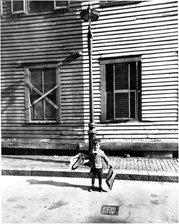 At the age of about four (~1940), as assistant to my father, I participated in the creation of the Boston Housing Authority. Collaborating with Lou Weinstein, a noted Boston attorney, Ernst did a series of drawings showing living conditions in some of Boston's less privileged neighborhoods. However, after their publication some doubted the authenticity of the conditions depicted. Ernst quickly taught himself photography, and he did a classic photo documentary series that left no doubt about the squalid conditions, which helped lead to urban renewal projects. It was at that time that I became his official assistant, going out into the neighborhoods dressed in shorts and a shirt, holding a number board that was almost as tall as me, to identify each photo.
At the age of about four (~1940), as assistant to my father, I participated in the creation of the Boston Housing Authority. Collaborating with Lou Weinstein, a noted Boston attorney, Ernst did a series of drawings showing living conditions in some of Boston's less privileged neighborhoods. However, after their publication some doubted the authenticity of the conditions depicted. Ernst quickly taught himself photography, and he did a classic photo documentary series that left no doubt about the squalid conditions, which helped lead to urban renewal projects. It was at that time that I became his official assistant, going out into the neighborhoods dressed in shorts and a shirt, holding a number board that was almost as tall as me, to identify each photo.
After World War II, America experienced an economic boom, and Ernst established the premier commercial photo studio in Boston. It was a classic family business, with all expected to act as assistants. On weekends and vacations the family would go on outings, walking the beaches and woods of New England; everyone had a camera in hand and we shared perspectives, viewpoints, and technical information. We also focused on documentary explorations of Boston, Cambridge, and New York. A summer as assistant to my uncle, Hal, rounded out my photographic education. Hal had established himself as the major commercial studio photographer in San Francisco. Later, as part of a college course in American life, I did a photographic documentary essay on life in a state mental hospital in Massachusetts.
In this way, from childhood through my college years, I learned not only the techniques of art and photography, and how to tell a meaningful story, but the ins and outs of being an entrepreneur.
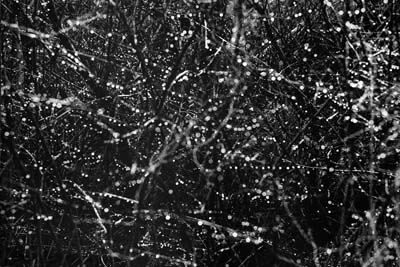 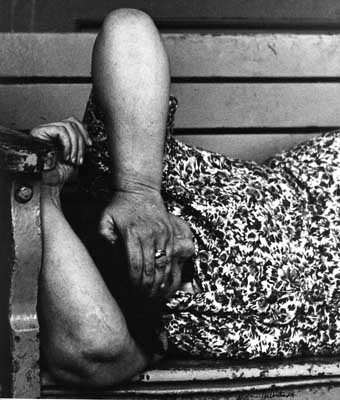 |
I considered a career as a photographer--Life Magazine was a goal. The Museum of Modern Art acquired one of my landscapes as well as Reclining Woman from my documentary essay, The Face of Mental Illness. However, I decided that I would apply anthropological science to improving society. After graduating from Harvard College, I attended Columbia University, studying anthropology under Margaret Mead, Conrad Arensberg, Ruth Bunzel, and others who were interested in documenting and analyzing human social interaction. My work there culminated in a documentary study of Navajo social, religious, and curative rituals, using photographs to document and illustrate patterns of behavior.
During my graduate studies I continued to do natural and documentary photography, and I did press assignments, including for The New York Times Magazine, and contract work covering civil rights activities and suburban life.
Over the years I have worked in a variety of professional positions, doing research and analysis and helping to develop policies and plans; including in the fields of mental health and nursing; and neighborhood development in both the United States and Israel.
In co-authoring and publishing a handbook on sleep apnea, I used my skills to turn my experiences into a kind of anthropological report on sleep, and with my collaborators, created a new concept of self-help book, combining the insights of a patient with the expertise of medical clinicians and scientists. Sleep Apnea--the Phantom of the Night
I have worked as an independent entrepreneur/family business in both the United States and in Israel, providing photographic services, writing and editing services, and publishing services. I have also been a consultant to entrepreneurial companies, focusing on strategic and visionary business plans, helping these firms to obtain significant investment and financing.
Since 1992 I have been publisher and president of New Technology Publishing, Inc., with a mission to enable people with chronic disease to better manage their conditions. Our publications uniquely meld authoritative medical information with the insights and perspectives of patients. A broader mission is to improve the care of chronic conditions by empowering and supporting patients and their families.
My children have been a continuing source of inspiration and pride. I photographed them as they grew, and marvelled as they developed their own artistic, managerial, and scientific talents. My daughter, Elana has worked in the theater, in television production, and as a stand-up comic. She is a talented artist and does wonderful paintings of animals; decorates clothing; and creates unique greeting cards. And she is a writer with much insight and great talent. Most wonderful are her roles as the wife of Andy and the mother of Max, quite possibly the most handsome, intelligent, and talented grandson on the planet earth. Planet Elana
My son, Ari, has always been a sensitive observer of nature, attuned to living things and he is both a scientist and an artist. He has been a software engineer and most recently earned a Masters degree in the biology of neurological development at the University of North Carolina at Chapple Hill. He is an accomplished and sensitive photographer of nature. His current project is world-wide travel and photography. Ari's blog and photo album has insightful and sensitive insights into the world he observes, and the photographs are marvelous documents and artistic portrayals of people and places.
Their mother, Carol, is an artist, and has done drawing, oils, murals, and graphics. She is a poet as well as an exceptional editor. About Carol at Migrations.com Carol is a cofounder and the coordinator of a nonprofit fair-trade enterprise of the Dine (Navajo) of Black Mesa, Arizona, empowering Dine families and communities through the sale of wool weavings, and handspun yarn made from the fleece of the rare Navajo-Churro sheep. Black Mesa Weavers for Life and Land.
I have learned, and continue to learn, from each of them. Incidentally, the logo of the hand grasping the sun is a 'made' sunburst (photo made with Carol), and is a visual play on the role of light and shade in photography.
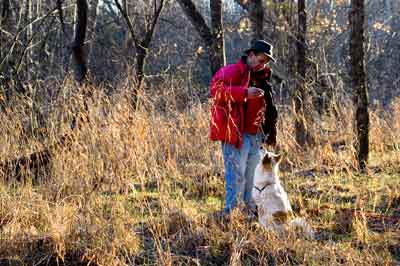 I have fond memories of walking with Keshet (Rainbow), my son's Canaani dog, and with family and friends in the hills of Jerusalem, Israel. The Canaan dog is an ancient breed native to the Israeli desert. I wanted a similar dog as my walking companion. In the spring of 2003 I received Keren, then an eight-weeks old female Canaani puppy, and she immediately claimed me as her own. Until 2005, Keren and I lived overlooking the beach in Onset, Massachusetts, on the upper part of Cape Cod, and we walked along the water at least twice a day. As Keren attended to dog business--sniffing, digging, rolling in previously living organic matter, swimming, and running after birds--I was free to enjoy the natural beauty of the seascape and landscape. I began to photograph Keren as well as the views, using for convenience one-time use cameras. On selected days I used my old 35mm film camera, a Nikon F. I was deriving much pleasure from the scenery as well as from Keren on those walks, and determined to take up photography again. When digital photographic technology advanced to a level permitting quality work, I switched over to digital. So the photographs presented here owe their existence to my walks with Keren. She goes with me almost everywhere, we are collaborating on some books (she is a talented writer), and she continues to inspire my picture making. Keren's full name in Hebrew means "Sunburst." She has taught me why a dog is considered a man's best friend. (Photo of Jerry and Keren, Eno River NC, Copyright © 2004 Ari Halberstadt)
I have fond memories of walking with Keshet (Rainbow), my son's Canaani dog, and with family and friends in the hills of Jerusalem, Israel. The Canaan dog is an ancient breed native to the Israeli desert. I wanted a similar dog as my walking companion. In the spring of 2003 I received Keren, then an eight-weeks old female Canaani puppy, and she immediately claimed me as her own. Until 2005, Keren and I lived overlooking the beach in Onset, Massachusetts, on the upper part of Cape Cod, and we walked along the water at least twice a day. As Keren attended to dog business--sniffing, digging, rolling in previously living organic matter, swimming, and running after birds--I was free to enjoy the natural beauty of the seascape and landscape. I began to photograph Keren as well as the views, using for convenience one-time use cameras. On selected days I used my old 35mm film camera, a Nikon F. I was deriving much pleasure from the scenery as well as from Keren on those walks, and determined to take up photography again. When digital photographic technology advanced to a level permitting quality work, I switched over to digital. So the photographs presented here owe their existence to my walks with Keren. She goes with me almost everywhere, we are collaborating on some books (she is a talented writer), and she continues to inspire my picture making. Keren's full name in Hebrew means "Sunburst." She has taught me why a dog is considered a man's best friend. (Photo of Jerry and Keren, Eno River NC, Copyright © 2004 Ari Halberstadt)
